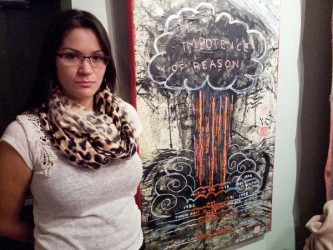Article Origin
Volume
Issue
Year
“There’s some wicked things that come out of the nuclear industry,” said Kirstin Scansen. She was speaking Dec. 12 at an event called Radioactive Colonialism: Uranium and the Dispossession of the Nehithaw Cree and Denesuline Peoples. The evening, attended by about 60 people, was organized by Idle No More Toronto.
Scansen is Cree from the Lac La Ronge Indian Band, a community located 420 km north of Saskatoon.
“In the territory where I come from, and in the northern territories of the Denesuline people, is where the uranium industry in Canada starts.”
Scansen’s a graduate student in Indigenous Governance at the University of Victoria. Her graduate work focuses on the interaction between uranium mining and milling in northern Saskatchewan and the global nuclear industry.
Scansen works with the Committee for Future Generations (CFFG), a group of northern Saskatchewan residents opposed to a high-level nuclear repository in the north.
The Dene and her own people, the Cree, had teachings about uranium, Scansen said.
“They knew, and we knew it existed,” she said. “We had specific teachings on what we were to do with it and we were to leave it alone. Often I’ll hear the industry speak about ‘acceptable limits’ and our teachings have been for thousands of years that acceptable limits are nothing. You are not to touch it and so people did not touch it.”
Scansen spoke about the Fukushima disaster and explained that part of the uranium that is processed and made into fuel for fission at Fukushima came from Saskatchewan.
“I’m ashamed that it comes from my territory,” she said.
It’s not only in Japan that people are suffering the ill effects of Canadian uranium. It’s been used in weapons for the Gulf War, and in Iraq and Afghanistan. In her own home territory, 14 per cent of the membership works for the uranium mines in catering, trucking or underground.
While they don’t necessarily agree with the industry, she said, they do it because they need jobs. They’re not informed of the risks. She’s heard the Canadian Nuclear Safety Commission say that the natural uranium that comes out of the mines is not unhealthy for you.
In reality, she said, radiation causes problems when it’s inhaled, and when you inhale it underground it gets into your lungs. Mine workers around the world are at higher risk for lung cancer, Scansen said. When they inhale the dust, not only does the carcinogenic material start to accumulate in their lungs but it also alters the make-up of the lungs.
There are two corporations that operate the uranium mines in Scansen’s territory.
“Their strategy to gain consent in our community is very powerful,” she said. They sponsor kids’ hockey teams, provide scholarships and go into the schools to bring children into careers in the industry. The school presentations are on “all the wonderful things the children can grow up to be when they get older, such as underground worker at the mines…”
The industry’s latest strategy is appropriating the ceremonial ways, Scansen said, something that does not sit well with her community. Industry print material contains a section on traditional knowledge.
“Those principles are what keep us alive, what keeps us thriving as nations, what keeps us close to God… One of the principles that they’ve appropriated is the idea that if you take something from the earth, you need to put something back… so you take the uranium from the earth, you put the nuclear waste back in, a billion times more radioactive,” Scansen asserts.
The industry has stepped up their efforts to find a host community for a high level nuclear waste repository. There is a huge problem with high level nuclear waste in Canada that is piling up at nuclear facilities in Ontario.
In 2002, the government legislated the creation of the Nuclear Waste Management Organization which has been mandated to find a solution.
The nuclear waste that is produced is self-generating thermal heat and from its creation, the waste must be cooled constantly in water for seven to 10 years. They’re put in containers that are open to the wind which helps with the cooling process. What they want to do now, said Scansen, is bury the waste permanently in containers underground and they are hoping the surrounding granite will absorb the heat. They have no idea if this will actually occur, she said.
“They literally have no clue.”
The CFFG recently scored a major victory against the industry when two communities – Pinehouse, a predominantly Metis settlement, and English River First Nation–were removed from the list of potential host communities for nuclear waste.
“I still can’t get over the fact that from the territory that I live on comes that evil,” said Scansen. She urged people to educate themselves about the industry and to take action to protect themselves and their territories.
- 6229 views

